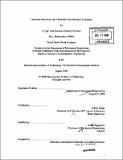| dc.contributor.advisor | Robert Haupt and Arthur Baggeroer. | en_US |
| dc.contributor.author | Doherty, John Houston | en_US |
| dc.contributor.other | Woods Hole Oceanographic Institution. | en_US |
| dc.date.accessioned | 2009-06-30T17:12:00Z | |
| dc.date.available | 2009-06-30T17:12:00Z | |
| dc.date.copyright | 2008 | en_US |
| dc.date.issued | 2008 | en_US |
| dc.identifier.uri | http://hdl.handle.net/1721.1/46058 | |
| dc.description | Thesis (S.M.)--Joint Program in Oceanography/Applied Ocean Science and Engineering (Massachusetts Institute of Technology, Dept. of Mechanical Engineering; and the Woods Hole Oceanographic Institution), 2008. | en_US |
| dc.description | Includes bibliographical references (p. 54-56). | en_US |
| dc.description.abstract | Landmines and mine-like traps are effective weapons that are difficult to detect and discriminate from a safe distance. The ability to detect landmines in their host environment at a distance and to discriminate them from other objects would be valuable for countering the landmine threat. This paper explores a standoff acoustic/laser technique to discriminate landmines from other forms of man-made objects (clutter) in an urban environment. A novel approach currently under investigation by MIT Lincoln Labs, University of Mississippi, and other groups employs a non-contact acoustic/laser technique to detect landmines from a safe standoff range. This technique uses a sound source to excite vibrations in targets with an acoustic wave. These vibrations are in turn measured remotely with a Laser Doppler Vibrometer (LDV). In this thesis, the vibration responses of landmine variants are measured, analyzed, and compared to those of common urban objects likely to be found on a landmine field or roadside. The Fourier Transform of the vibration of the target as measured by the LDV is used to generate a target vibration spectrum. Target vibration spectra in response to a sound source were experimentally measured for 59 trials, 28 of which were of simulated landmine variants and the remaining trials were of urban clutter objects. Using an algorithm adapted from a methodology for mass spectral analysis, parameters of the target signatures are estimated; then individual target signatures are classified using a Support Vector Machine (SVM) with a training set composed of parameters from the remaining members of the total population. The best results obtained from this methodology had a 71% probability of detection and a 3% false alarm rate corresponding to 20 of 28 of the simulated landmine variants correctly identified and a single clutter object misidentified as a landmine variant. | en_US |
| dc.description.statementofresponsibility | by John Houston Doherty. | en_US |
| dc.format.extent | 120 p. | en_US |
| dc.language.iso | eng | en_US |
| dc.publisher | Massachusetts Institute of Technology | en_US |
| dc.rights | M.I.T. theses are protected by
copyright. They may be viewed from this source for any purpose, but
reproduction or distribution in any format is prohibited without written
permission. See provided URL for inquiries about permission. | en_US |
| dc.rights.uri | http://dspace.mit.edu/handle/1721.1/7582 | en_US |
| dc.subject | /Woods Hole Oceanographic Institution. Joint Program in Oceanography/Applied Ocean Science and Engineering. | en_US |
| dc.subject | Mechanical Engineering. | en_US |
| dc.subject | Woods Hole Oceanographic Institution. | en_US |
| dc.subject.lcsh | Sound-waves | en_US |
| dc.subject.lcsh | Solids Acoustic properties | en_US |
| dc.title | Landmine detection with a standoff acoustic/laser technique | en_US |
| dc.type | Thesis | en_US |
| dc.description.degree | S.M. | en_US |
| dc.contributor.department | Joint Program in Oceanography/Applied Ocean Science and Engineering | en_US |
| dc.contributor.department | Woods Hole Oceanographic Institution | en_US |
| dc.contributor.department | Massachusetts Institute of Technology. Department of Mechanical Engineering | |
| dc.identifier.oclc | 374152656 | en_US |
